In this course, you will learn about risk assessment techniques and how to implement a number of strategies that will ensure the protection of assets. You will learn about the relationship between assets, vulnerabilities, threats, and risks. You will also engage with a number of current case studies in the industry that illustrate the material. You will leave the course with skills relating to threat modeling and business continuity planning that have direct applications at your current job or in your future career.


Introduction to Risk Management
This course is part of Introduction to Cybersecurity & Risk Management Specialization
Taught in English
Some content may not be translated

Instructor: Qasim Ijaz
8,765 already enrolled
Included with 
Course
(103 reviews)
Details to know

Add to your LinkedIn profile
4 quizzes
Course
(103 reviews)
See how employees at top companies are mastering in-demand skills

Build your subject-matter expertise
- Learn new concepts from industry experts
- Gain a foundational understanding of a subject or tool
- Develop job-relevant skills with hands-on projects
- Earn a shareable career certificate


Earn a career certificate
Add this credential to your LinkedIn profile, resume, or CV
Share it on social media and in your performance review

There are 4 modules in this course
Welcome to the first module of Introduction to Risk Management. In this module we focus on understanding what a risk is and the range of dependencies that a risk may rely on. We will also list and describe risk assessment techniques that can help you better understand any risk landscape. Finally, we will discuss how to present identified risks to your leadership for better decision making.
What's included
4 videos1 reading1 quiz1 peer review
Welcome to Module 2! Now that we have practiced identifying risk, we will discuss the means to manage it. In this module you will be introduced to the three categories of controls, as well as the six steps of the Risk Management Framework (RMF).
What's included
3 videos1 reading1 quiz1 peer review
Welcome to Module 3! This week, we discuss the art of threat modeling. Being able to threat model is an important skill for security professionals, as well as other professions within the computing realm. Threat modeling can help with early identification of security issues, make the organization more efficient, and offer a better understanding of how prone the organization and its assets are to attacks.
What's included
4 videos1 reading1 quiz1 peer review
Welcome to the fourth and final module of Introduction to Risk Management! Information systems play critical role in today's business, hence it's important to have a continuity plan for information systems, as well as your other business functions. A business continuity plan enables business and its IT infrastructure to withstand any likely disruptions. Whether you're working towards a CISSP certification or a role in risk management, it is very important to understand the role business continuity plays in continuation of critical business operations.
What's included
5 videos1 reading1 quiz1 peer review
Instructor

Offered by
Recommended if you're interested in Computer Security and Networks

University of California, Irvine

University of California, Irvine

University of Illinois at Urbana-Champaign

The Hong Kong University of Science and Technology
Why people choose Coursera for their career




Learner reviews
Showing 3 of 103
103 reviews
- 5 stars
79.80%
- 4 stars
13.46%
- 3 stars
3.84%
- 2 stars
0.96%
- 1 star
1.92%
New to Computer Security and Networks? Start here.

Open new doors with Coursera Plus
Unlimited access to 7,000+ world-class courses, hands-on projects, and job-ready certificate programs - all included in your subscription
Advance your career with an online degree
Earn a degree from world-class universities - 100% online
Join over 3,400 global companies that choose Coursera for Business
Upskill your employees to excel in the digital economy
Frequently asked questions
Access to lectures and assignments depends on your type of enrollment. If you take a course in audit mode, you will be able to see most course materials for free. To access graded assignments and to earn a Certificate, you will need to purchase the Certificate experience, during or after your audit. If you don't see the audit option:
The course may not offer an audit option. You can try a Free Trial instead, or apply for Financial Aid.
The course may offer 'Full Course, No Certificate' instead. This option lets you see all course materials, submit required assessments, and get a final grade. This also means that you will not be able to purchase a Certificate experience.
When you enroll in the course, you get access to all of the courses in the Specialization, and you earn a certificate when you complete the work. Your electronic Certificate will be added to your Accomplishments page - from there, you can print your Certificate or add it to your LinkedIn profile. If you only want to read and view the course content, you can audit the course for free.
If you subscribed, you get a 7-day free trial during which you can cancel at no penalty. After that, we don’t give refunds, but you can cancel your subscription at any time. See our full refund policy.

